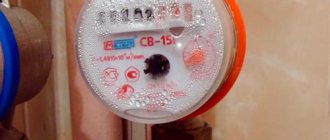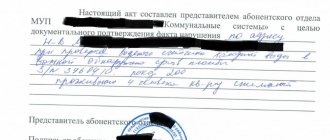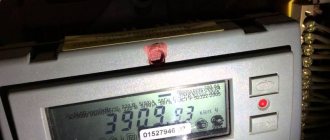When moving into a new home, the question will definitely arise whether to install a water consumption meter or do without it. Meters (MC), despite the hassle associated with their installation, bring significant benefits.
In addition to the initial installation costs, additional cost items arise over time - replacement of water meters. The article provides reasons, methods, as well as step-by-step instructions and useful tips to reduce the cost and time of replacing water meters.
Reasons for changing water metering equipment
During the mandatory inspection, factors may be identified that indicate the need for repair or replacement of the device.
The owner of the apartment may suspect a malfunction in two cases: the correctness of the readings is in doubt, or the arrow does not move when the water is turned on (and vice versa).
Causes:
Installation errors: a cold water meter was installed on a hot water supply pipe. This will cause incorrect readings and rapid breakdown.- External influence on the device: installing magnets and other methods to artificially lower indicators cause not only distortion of information, but also breakdowns.
- Leakage: If the stopcock is faulty, water will leak, resulting in incorrect results. Externally, this is indicated by a fogged indicator window.
- Blockages. The presence of solid elements in the water will lead to blockages in the PU flow element and the meter will break. This is why it is so important to use filters.
- Malfunction of the impellers or the counting mechanism, in which the rotation of the dial indicator is absent or intermittent.
- Exceeding the maximum permissible temperature for hot water meters: the maximum value for hot water meters is 90 °C. You can control it using thermometers like TK-110.
Important! If a malfunction is detected in the water meter, you can send it for repair, if possible. A broken device must be replaced.
Who should carry out the work?
Legislative and regulatory acts do not stipulate who specifically has the right to replace a faulty water control device. Owners can involve any legal entity or individual who has the necessary equipment to perform this service.
The organization (or individual entrepreneur) must undergo accreditation and also provide a license confirming the right to carry out such work. A prerequisite is the conclusion of a performance contract. After installation, the organization must provide a certificate of commissioning.
More detailed information on the issue here.
Legality of independent change
Since there is no direct prohibition in the legislation, the user has the right to replace a faulty meter with his own hands.
The only obstacle may be a clause about the inadmissibility of independently carrying out such work in the contract with the management company (or with the service provider, if the contract is directly with them).
Therefore, it is necessary to carefully study the agreement with the management company, if there is one, and also be sure to notify it.
Before starting work, you will need to agree to turn off the riser , as well as stock up on a set of tools and insulating materials.
The consequences of incorrect installation are not limited to a damaged device: in the worst case, independent actions can lead to flooding of your own and neighboring apartments.
Keep in mind: You need to be confident in your own skills and weigh the pros and cons of hiring professionals. Another disadvantage of manual installation is the lack of warranty.
Read about the legality of replacing the meter yourself in this article.
At whose expense is the equipment updated?
According to Federal Law No. 261 (Article 13), payment for the replacement of water consumption meters is borne by the owner of the property. If the apartment is municipal, then the municipality pays.
The following can count on a free change:
- citizens with disabilities of the first and second groups;
- the poor;
- citizens raising children with disabilities;
- WWII participants.
Other categories of citizens pay for the replacement of water pumps themselves, unless local authorities provide otherwise.
For example , in St. Petersburg, pensioners are exempt from paying the cost of work.
You can find more information about the cost of replacing appliances in this article.
Is it possible to independently replace the metering device?
Let's see how to replace water meters yourself. For example, the device has failed. Is it possible to change it yourself or do you need to use the services of specialist plumbers from their housing department, management company and other organizations? What should an apartment owner do?
The procedure for replacing water meters in an apartment requires approval in any case. To replace it, it may be necessary to turn off the water supply throughout the riser - residents cannot make such decisions on their own. This is done by the house management company. Before changing the water meter, it is better to find out the position on this issue from the management of the housing company. If the housing department claims that it is necessary to call an appropriate specialist for replacement, then it is better not to start a dispute. This is the procedure for replacing meters in an apartment in a particular building. There's nothing you can do about it. At the same time, residents and apartment owners are not legally prohibited from installing meters or changing them themselves.
If the meter has already been installed, then installing a new one in its place will not be difficult. Even a person who is holding a key in his hands for the first time can do this. However, after installation, the procedure for replacing an independent water meter in an apartment requires that housing department workers check the correct installation of the device, put a mark in the technical data sheet and seal the device.
Differences in procedure for hot and cold meters
When replacing a meter, the question often arises about the differences between cold and hot water meters. To avoid mistakes, it is necessary to understand whether there are technical differences in the PUs themselves and the features of their installation.
If we are talking about water meters of the same type, then there are practically no differences in structure . The most popular type is the type of non-volatile mechanical meters on an impeller.
External discrepancies concern only the color of the body: blue ones are for cold water supply, red ones are for hot water supply. This eliminates confusion when taking readings. The second option is a letter designation (x - cold, g - hot water).
Despite the absence of differences in structure, you should choose the device carefully.
If a cold water meter is placed on a hot water supply pipe, it will not last long.
The point is different workloads, since PUs have different temperature operating conditions:
- for cold water meters (cold water supply), the operating range is +5...+30 °C (40-50 °C for some types);
- for DHW (hot water) water meters, the maximum permissible temperature at the top point is 90 °C.
Heat-resistant materials were used in the manufacture of the latter. However, recently, universal meters have become more common, which can be used for both cold and hot water metering.
Attention! There are no differences in the installation of devices of different types. The only thing that needs to be taken into account is which pipe to block during installation.
Price
There is also no difference in the cost of the work: it is identical for both cold water supply and hot water supply. The price of PUs has leveled off with the advent of universal types: it depends on the manufacturer and the type of meter (industrial/household, electrical/mechanical).
For example, the most popular household mechanical water meter of the vane type among users costs 580-660 rubles , and an industrial one costs from 3,700 to 6,000 rubles.
The cost of installation does not depend on the type of pipe (DHW or cold water) on which installation is carried out.
But there is a dependence on the price of the device itself, the region of residence, as well as the accompanying difficulties of dismantling/installation (difficult access to the mounting location, communications hidden under tiles, decorative elements that are “delicate” in handling, hiding the meter). On average, the cost of work starts from 500 rubles.
Reference! In 2019-2020 Some consumers will have access to fillings free of charge.
This requires two conditions:
- the owner installs the device for the first time;
- replacement occurs due to the expiration of the verification period.
Free installation is only available to certain categories of citizens described in the previous section, provided that there are no restrictions in local laws.
Since the installation of water meters is a voluntary decision, you can count on free provision of water meters only as part of special promotions by local authorities or the developer when putting a house into operation.
Do I need to change it or is verification enough?
You need to understand the differences between these two processes:
The cost of verification is around 600 rubles, while replacement will cost approximately 500 rubles (depending on the region) plus the price of a new meter. The first option is cheaper.- Additional expenses. Here everything is ambiguous: in the case of verification, they are possible, since it may become clear that there is a need for urgent repair of the device; when replacing, expenses for unforeseen needs (materials, opening the casing or decorative masking structures) cannot be ruled out.
- Guarantee . When replacing, the user receives a warranty period, during which the service that carried out the work undertakes to correct possible problems, just like the manufacturer of the device. There are no guarantees during verification.
- Dismantling and associated negative aspects. It is impossible to replace the device without quite long (from half an hour or longer) manipulations associated with dirt, dust; deformation of the box is possible if the meters are hidden. Verification is a faster (no more than twenty minutes) and cleaner process, since it does not require dismantling.
In general, verification looks more attractive. But we must proceed from the feasibility of carrying out the work. For example, the meter has mechanical damage that cannot be corrected on site.
In this case, it is better to immediately replace it to avoid additional costs for verification or repairs, the cost of which may exceed the price of a new device.
Read a detailed article about when to change and when to trust here.
The stated reason for replacing the IPU is not true
The owner filed a lawsuit, demanding that the organization return the money and also compensate for moral damages. The magistrate found that the company was obliged to return the fee for services to the owner of the apartment, as well as compensate her for moral damages and pay a fine - a total of 8,700 rubles.
The defendant did not agree with this decision and filed an appeal, noting that the consumer voluntarily entered into an agreement, there were no complaints about the quality of the goods from her, therefore there are no grounds for a refund. In addition, according to the company, the owner has not proven that this transaction was concluded under the influence of misconception or deception.
However, the district court agreed with the magistrate's findings and upheld his decision. The conclusions of the courts of both instances were based on the following theses and evidence of the organization’s guilt:
- Compulsion to enter into an agreement is not permitted, except in cases where the obligation to enter into an agreement is provided for by law or by a voluntarily accepted obligation (Part 1 of Article 421 of the Civil Code of the Russian Federation).
- A transaction made under the influence of a mistake may be declared invalid by the court if the mistake was so significant that, knowing the actual circumstances, the party to the contract would not have entered into it (Article 178 of the Civil Code of the Russian Federation).
- In the order for replacing the electricity meter, drawn up by the defendant company, the reason for replacing the IPU indicated the expiration of its verification period.
- The technical documentation of the dismantled meter states that its calibration interval is 16 years, and it was released in August 2004. Consequently, the owner’s obligation to replace the IPU arose only in 2021.
- The energy supply contractor checked the new IPU and drew up a report indicating that the meter was installed in violation of the rules for electrical installations. The device is not approved for operation and is not rated.
Based on these facts, the judges concluded that the service of dismantling old meters and purchasing new ones was imposed on the owner: she was misled. Therefore, the company is obliged to return the money to the plaintiff for the service, the contract must be terminated, and the owner must transfer the acquired private investment property to the defendant.
Also, in accordance with Art. 15 of the Law of the Russian Federation dated 02/07/1992 No. 2300-1 “On the Protection of Consumer Rights”, the organization must compensate the owner of the apartment for moral damages in the amount of 2,000 rubles and pay a fine in the amount of 50% of the amount awarded to the consumer.
How to change - procedure
The decision to change the water meter has been made. According to the established rules, first of all it is necessary:
purchase a new metering device and carefully check its completeness;- determine the location: whether to put it in the same place as before, or, taking the opportunity, change it to a more convenient one;
- take into account illumination, free passage and convenience of taking readings;
- notify the management company and call a specialist to legalize the actions to replace meters.
Where to contact?
Where to go depends on the owner’s decision : whether the replacement will be done manually or by a master.
In the first case, you will need to notify the management company or the service provider and call a specialist to check the integrity of the seals, record the meter readings before dismantling work and unseal the device. It is prohibited to carry out such actions on your own.
In the second case, it is enough to call a specialist who will carry out all the same actions, and also dismantle the old device and install a new one. He will also have to issue all the necessary documents upon completion of the work.
Attention! The question of whether the MFC carries out such work is increasingly occupying the minds of apartment owners. This is due to a wave of fraudulent activities: representatives of the supposed MFC call users and, under various pretexts, strongly recommend replacing the meter, citing new laws.
Under threat of fines, they send a technician to replace a working (and sometimes new) meter and make money from it. The MFC on its official website urged not to succumb to such persuasion, since neither multifunctional centers nor the water utility never conduct telephone conversations; this is illegal.
What are the documents for reinstalling water meters?
To replace a water meter, you need to provide a list of documents.
Main list
Accredited organizations with a license to carry out such work claim that no special documents will be required when engaging them.
But in some cases (self-installation, master from the management company) you will need:
- Application for meter replacement.
- Identity card of the apartment owner and document on ownership.
- Accompanying documentation and technical passport for the replaced (old) device.
Whether these documents are required or not - you need to clarify this survey with the Criminal Code or Vodokanal by phone.
After carrying out the work, the master (or replacement specialist) must provide the following documents:
- certificate of work carried out to reinstall the control unit;
- technical passport and accompanying documents of the new launcher;
- receipt for payment for reinstallation services performed;
- certificate of proper quality of the new device during verification.
Drawing up an application
You can find out if an application is needed by calling. It is enough to contact the management company or water supply service provider. They may provide an application form or ask you to write one yourself.
In the second case, you need to remember the following points:
- At the top of the application there must be an address of application (UK or Vodokanal);
- next is the word statement, under it there should be a request to install the meter in any form;
- below is the address of the apartment/house;
- telephone number by which the technician will contact the user;
- information about the attached documents (for example, payment receipts);
- Full name of the applicant, below – signature and date of application.
Important! A prerequisite is the applicant’s current contact information, an accurate and detailed address, written legibly.
Drawing up an act
Filling out the act is regulated by law. Government Decree No. 354 (dated 05/06/2011) mandatory prescribes:
- the exact address where the reinstallation should be carried out;
- localization (for example, a bathroom, pipe or cold water riser);
- information about the device being replaced;
- information about the new PU;
- the exact date of reinstallation, coinciding with the day of signing this document;
- the performing organization, as well as the license number confirming the right to carry out such work;
- signature of the specialist who carried out the reinstallation.
Dismantling the old device
Before starting work, you must turn off the water to the riser. To do this, you need to call the management company, or turn off the valve yourself if it is located in the apartment.
Next, drain the remaining liquid by opening the mixer. You will also need rags to remove any remaining liquid from the pipe at the dismantling site.
Then the following steps are performed step by step:
Using an adjustable wrench, loosen the fastening nuts of the old device. If they don’t give in, you can heat them slightly, or use a special solution.- If there is a pronounced distortion of the pipes, they are fixed with a wrench.
- The fitting is cleaned: rust and dirt must be removed.
- The mounting area is dried.
At the final stage, debris is removed from the coarse filter.
Installation of a new
Before installation, the inlet and outlet openings on the device are determined. Confusion will lead to incorrect readings and malfunctions.
If there is no corresponding arrow pointing to the entrance, you need to pay attention to the location of the plastic filter, which points to the entrance.
Further:
- Assembling the fitting: insert it into the threaded nut, screw it into the outlet on the pipe using a wrench.
- Place the rubber washer inside the nut.
- Wrap linen tape around the thread and moisten it evenly with silicone.
- Connect the new PU with a wrench to the pipes.
At the final stage, you need to check the tightness of the connection. All the taps in the apartment are closed and water is released through the riser. You can place filter or toilet paper at the fastening points. If it gets wet, you will need to tighten the connections.
The conclusion about the need to replace the IPU was not made by the utility service provider
In addition to putting new devices into operation, the CP contractor is obliged to check the condition and reliability of the readings of the IPU in a residential premises at least once a year, but not more than once every three months (clause 83 of RF PP No. 354).
If the metering device is installed in a place accessible for inspection or in a non-residential premises, then the contractor has the right to check the meter once a month (clause “d”, clause 32 of RF PP No. 354).
If, when checking the IPU, the utility service provider determines that the meter verification period has expired or the device is out of order, a corresponding report is drawn up, and the owner of the premises is obliged to replace such IPU as soon as possible. Only the contractor has such rights.
At the same time, the calculation of fees for the corresponding utility service is carried out not according to indications, but “according to the average”. If within three months the meter is not replaced - based on consumption standards using an increasing factor of 1.5 (clause “a”, clause 59, clause 60 of RF PP No. 354).
What to do next?
After the reinstallation is completed and the necessary documents have been received, you need to register a new PU.
Otherwise, the meter readings will not be taken into account when calculating utilities.
The payment amount will be calculated in the traditional way based on the residents.
The documents listed earlier in the article (acts for reinstallation and proper quality of the device, registration certificate and payment receipt) are sent to the DEZ, and from there to the EIRC, where the water meter is registered.
Where to put the dismantled equipment?
Mechanical meters do not pose any danger in terms of toxicity. A broken PU or water meter can simply be thrown away after its service life has expired. But it's better to recycle it.
The meter contains non-ferrous metals, and therefore they are in demand on the recyclables market. There are advertisements online about the acceptance of dismantled devices for a fee: you can also make money from an obsolete control panel.
Verification
After commissioning, the new meter does not need to be verified, since the manufacturer checks the product before sale. The next verification date must be noted by the manufacturer in the data sheet.
An exception is the installation of a device that has been in storage for too long. This can be avoided by carefully studying the production date of the PU before purchasing.
Is filling required?
After commissioning, the metering device must be sealed by a representative of the Management Company or Vodokanal.
The procedure is mandatory and free. To obtain it, you need to fill out an application for sealing, or call a specialist by phone.
The procedure for putting a new meter into operation was not followed
Individual metering devices, including electricity, are the responsibility of the owner of the premises to account for the consumption of resources in which they are installed. It is the owner who is obliged to ensure that the meter verification period has not expired, the mechanism is not damaged, and the seals installed on the IPU are not damaged (clause 81 of RF PP No. 354).
After installing a new meter or replacing a faulty one, the provider of the corresponding utility service must, without charging any fee at the owner’s request, accept the IPU for calculations (clause 81 (9) of the RF PP No. 354).
At the same time, a representative of the CU contractor checks how the IPU is installed, the documentation for the device, seals the meter and records the initial readings. After this, an act of putting the device into operation is drawn up (clauses 81(4), 81(6) RF PP No. 354).
How to commission and seal an individual meter
11758310











